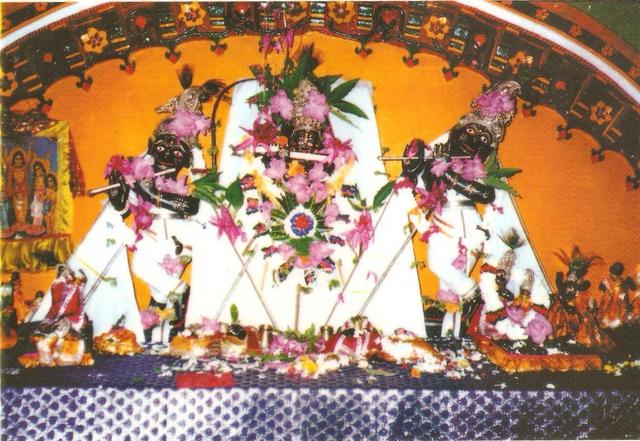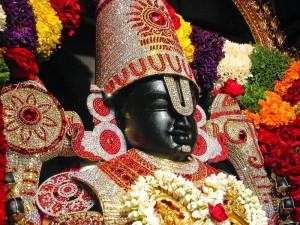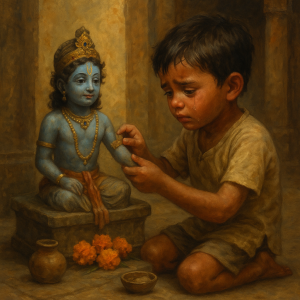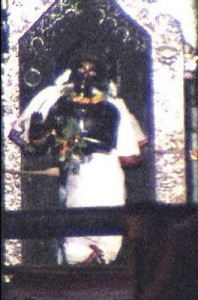Vallabhacharya’s Verse “Braje Vasantam Navaneta Chauram, Brajagananam Vasanaika Charam Aneka Janmarjita Papa Chauram Chauragraganyam Purusam Namami
Meaning: Beware, residents of Gokul! A dangerous thief has snuck into Braj. What does this thief steal, you ask? He steals the clothes of the Gopis while they bathe and butter from their homes when they are away. Oh greatest stealer of the universe! Have mercy on me. Kindly steal away the burden of sins I have accumulated over many births. I salute you, oh greatest stealer.”
— Shri Vallabhacharya
The Origin of Sri Gopinatha in Remuna
In the Treta Yuga, Lord Rama was in exile and spent time at Chitrakut with Sita and Lakshmana. Enchanted by the natural beauty of the place, they decided to stay there for a while. One day, as Lord Rama watched the cows grazing after a heavy rain, He smiled. Sita, noticing His smile, asked the reason. Rama explained that the scene reminded Him of His future incarnation as Krishna, the cowherd in Dwapara Yuga. Sita expressed her desire to see Him in that form.
In response, Rama took a piece of stone and inscribed on it the Tribhangi posture of Sri Krishna, with a flute in His hands. He also sculpted the figures of eight sakhis (gopis) serving Him—Lalita, Vishakha, Chitra, and Indulekha on the left, and Champaklata, Sudevi, Tungavidya, and Rangadevi on the right. Near Krishna’s feet, He portrayed His four dear companions—Sanandan, Subala, Vidagdha, and Madhumangala—along with cows and scenes of Krishna’s pastimes, such as the destruction of Chanur and Mustika.
Sita, delighted by the depiction, touched the figures and asked Rama how He had created them. Rama then touched the stone with the sharp end of His arrow, and to Sita’s amazement, the image began to bleed, bringing the figure to life. This divine vigraha (deity) was worshipped by Sita, and later by Lord Brahma.
The Journey of the Vigraha After Rama’s return to Ayodhya, the vigraha continued to be worshipped by Brahma through the Treta Yuga, Dwapara Yuga, and for many years into the Kali Yuga. During the Kali Yuga, King Langula Narasimha Dev of Orissa, a devout Vaishnavite known for his charity, embarked on a pilgrimage and eventually arrived at Chitrakut. The royal couple discovered the vigraha worshipped by Brahma and decided to bring it back to Srikshetra (Puri). However, that night, the deity appeared in the king’s dream, identifying Himself as Madanagopal, and commanded the king to take Him along.
The next day, the king and queen renamed the deity Jay Gopal and carried Him on their journey. As they rested at a place now known as Remuna, the Lord expressed His desire to stay there, as the region was rich in milch cows. The king, heeding the Lord’s wish, established the deity in Remuna and renamed Him Sri Gopinatha, as He was surrounded by His eight sakhis and companions.
The Kheer Chora Miracle
Over time, the deity became known as Kheer Chora Gopinatha due to a miraculous event involving the great saint Madhavendra Puri. The deity had once stolen a pot of kheer (a sweet rice pudding) for Madhavendra Puri, a gesture that earned Him the affectionate title “Kheer Chora” (the thief of kheer).
The original Gopinatha Temple in Orissa faced destruction during Muslim invasions but was later renovated by the Vaishnava saint Rasikananda. It is said that Rasikananda found the deity’s idol hidden in a pond, about four kilometers from the temple, where it had been concealed to protect it from harm. Rasikananda’s samadhi (tomb) is located within the temple, and Madhavendra Puri’s samadhi is also nearby.
The Current Worship of Gopinatha
Today, Lord Gopinatha is worshipped on the altar alongside Sri Madana Mohana, Sri Govinda, Radha-Rasabihari, and Chaitanya Mahaprabhu, with Lord Jagannatha on one side and numerous Shalagram Shilas on the other. The black stone deity of Sri Gopinatha stands in bas-relief, while the deities of Govinda and Madana Mohana, brought from Vrindavana in about 1938 by Chaitanya Dasa Babaji, are free-standing.
Visiting the Temple To experience the full darshan of the deity, it is recommended to attend the Mangala Arati at 5:00 AM, as the vigraha is otherwise covered with a dhoti, revealing only His face and hands. The temple, with its rich history and divine atmosphere, continues to be a place of pilgrimage and devotion, drawing devotees who seek the blessings of Sri Kheer Chora Gopinatha.



